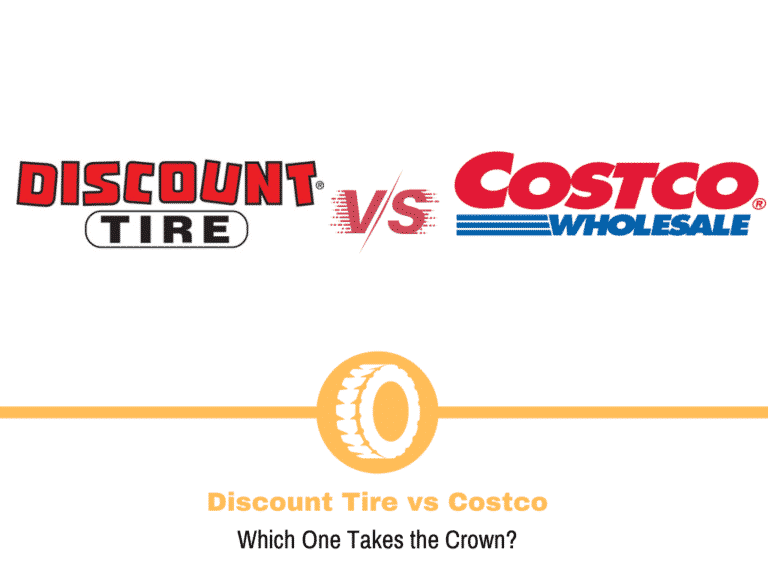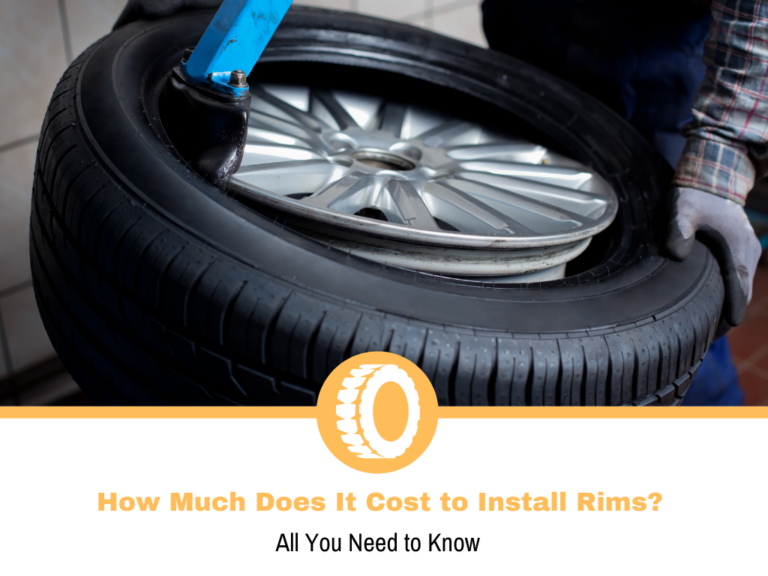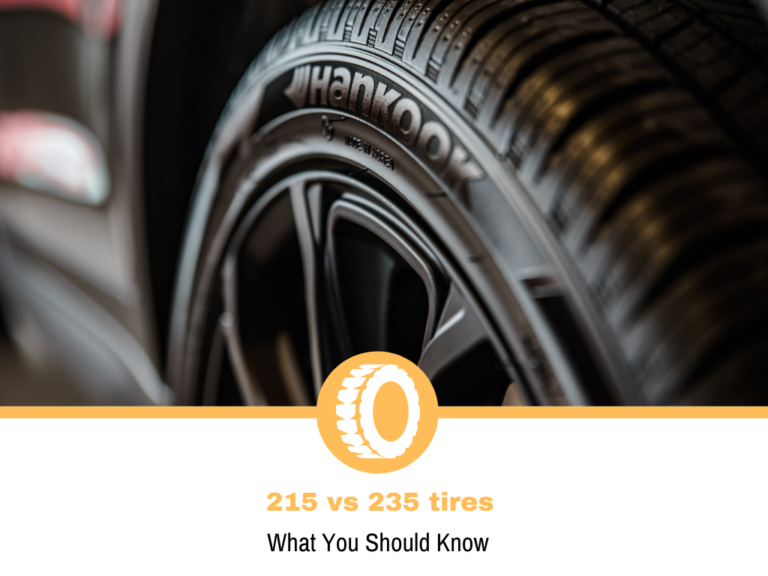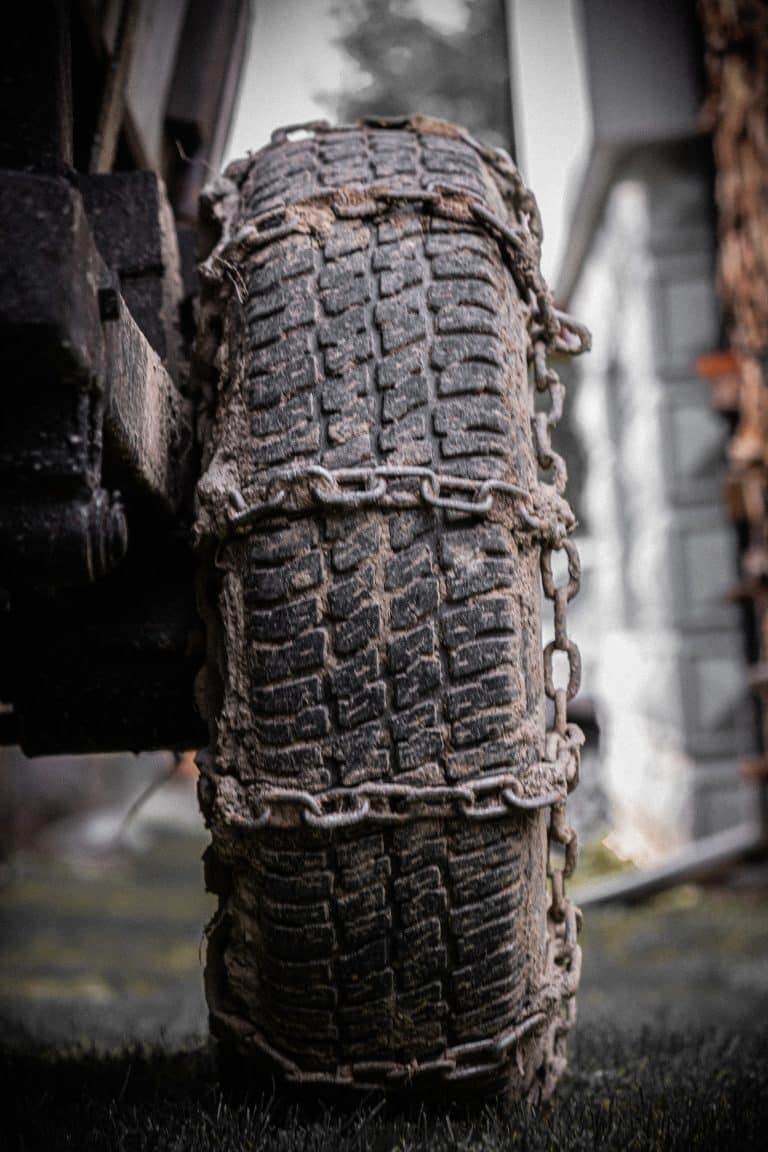What Happens if Tires Are Overinflated?
A car is a complex machine designed to deliver a specific type of performance. Some are more towards performance, others are comfortable, while a third type can be good at off-roading. Regardless of which type you’re looking at, it needs to have a set of tires to help it achieve that.
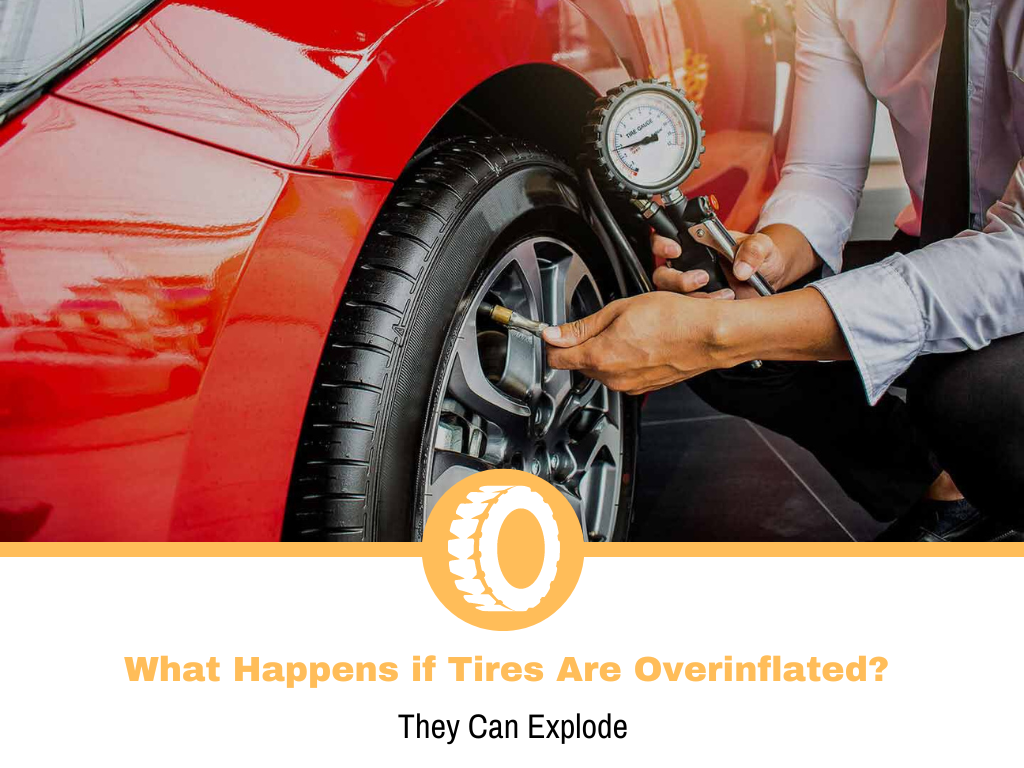
Tire manufacturers make many claims about how their models perform, and sometimes, they’re right. Naturally, every manufacturer will want to advertise its products in the best way possible, but they don’t always perform as claimed. The main thing that any manufacturer will say, which is true for all tires, is that they will perform the best when inflated per spec.
The car manufacturer determines a tire’s pressure, and with good reason. Tires get produced to operate under a wide range of pressure, and the exact number depends on the weight. This is where car manufacturers come into play, outlining the PSI at which the tires need to be inflated.
Any car model can come with multiple tire options from the factory, so car manufacturers add a sticker with all the information. This includes all the sizes and various speeds at which you plan to drive the car, so the pressure should be adjusted accordingly.
It’s all fine and dandy, but mistakes happen, and sometimes the tires can get overinflated. Wring readings, not paying attention, or maybe some “low-budget” tire shops can cause this. It’s not too common, but it can happen, and today I’ll be talking about that.
In this guide, I’ll explain what happens with a tire when it gets overinflated and how you can fix it.
Why Shouldn’t Tires Be Overinflated?
The definition of overinflated tires is broad, and depending on the pressure, you’re looking at different consequences. If the tires are a bit over the limit, it shouldn’t cause any immediate issues, but it will wear them unevenly in the long run. Too much over the specified pressure can cause a blown tire, which is a serious driving hazard.
How Do Tires and Pressure Work?
From the factory, manufacturers send out the tires without the rims. On their own, they have a certain shape; with nothing attached, they have no problem keeping the form as intended. As soon as they get fitted to the wheels, the weight squishes the sidewalls. Considering this, you can probably guess that the weight of a car will have all 4 tires pancakes beneath the wheels, which is where the pressure comes into play.
Once the tires are pressurized, they can carry the car’s weight and perform as advertised. The amount of pressure you put in the tires is important. Car manufacturers determine this through testing, mainly determined by the car’s weight and the tire’s size.
Here’s an example. Front-wheel drive cars usually have a few more PSI in the front tires because they carry the engine’s weight. The rear tires are generally less unless there’s a bigger load there, at which point you’ll need to increase the pressure.
On the opposite side of the spectrum, you have a rear-wheel drive car with wider tires in the back, where things are the other way around. The rear tires are wider, and even though they don’t carry the engine’s weight, the pressure should be a few PSI higher.
The numbers are gotten from plenty of testing, so it’s not like car manufacturers get things wrong.
What Happens to Overinflated Tires?
When tires are inflated and the car’s weight is applied, they should make full contact with the road. It means that the entire width of the contact patch should receive the same pressure. There are some minor variations with cars that have negative camber. For the sake of this guide, let’s consider cars with zero camber.
The shape of the tire is determined by the weight. To ensure “perfection,” the tire needs to be inflated according to spec. Going above that means that the tires will need more weight to be in the desired shape, contacting the road.
Since this is impossible, unless you plan to drive around with added weights, the tire will deform in a way you don’t want to. The internal pressures will push the central rib more to a point where the shoulder blocks won’t get the same amount of pressure.
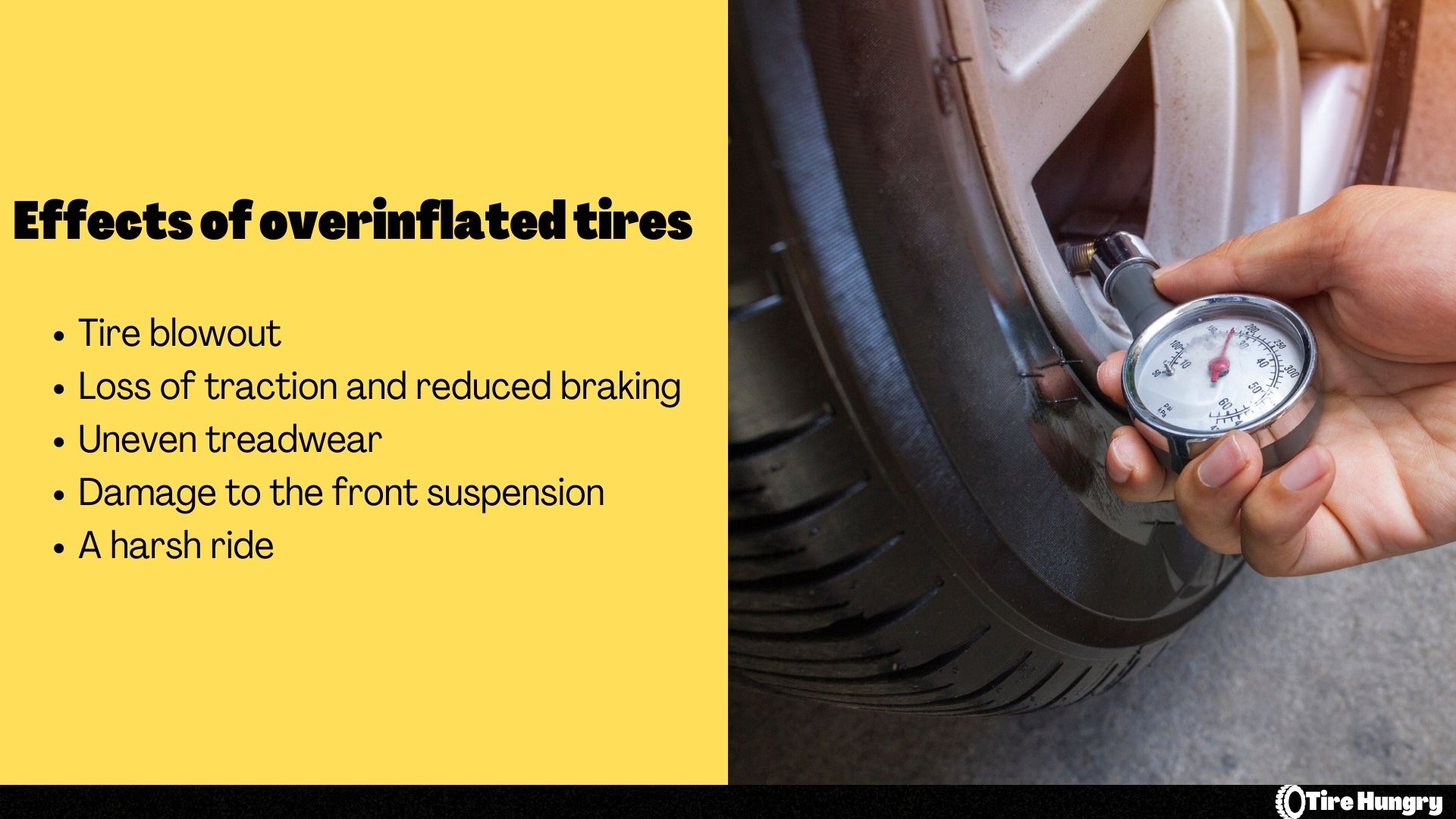
If the tires aren’t inflated too much past the normal values may not show any signs at first sight. To the naked eye, the tire may seem fine, and you could continue driving without knowing what you did. In reality, the bulge down the central rib will carry the total weight, while the shoulders will carry less. As a result, the central part of the tire will wear more quickly. I explained this in my guide on what causes uneven wear in tires.
Going further up the pressure scale, we have the ride quality. You may have noticed that the ride is a bit softer if your tires are a bit under the required specifications. The opposite will happen if the pressure is above spec. You’ll have a harder tire that isn’t as flexible, meaning that you’ll get a bumpier ride.
Finally, you’re risking a lot when you reach the upper limit of the pressure tolerances. The performance of the tires will be terrible, and hitting a pothole can cause a puncture. Trust me, a puncture on highway speeds isn’t fun.
How to Tell if a Tire is Overinflated?
I mentioned that an overinflated tire isn’t something you’ll notice just by looking at it. To be fair, if the tire has been driven for a while with pressure levels over the specified ones, you’ll notice increased wear on the central part of the tread.
If you just got your car from the tire shop or just finished adjusting the pressures of your tires, you’ll notice a few signs. An overinflated tire won’t have the same contact surface as one with normal pressure, so the traction levels will differ. The car will drive funny if there is more traction on one side. In some cases, you may notice it pulling to one side.
An important thing to note here is that if two tires on different sides are overinflated, you won’t notice any pulling. The traction levels will be similar, so the car will seem to drive fine.
The ride quality also takes a hit. Few people can notice any changes on one corner of the car. An overinflated tire is usually stiffer, so even if one has more pressure than it should, that corner will “feel” stiffer.
How to Fix Overinflated Tires?
Regardless of how one or more tires got to the point of overinflation, the solution is simple. The best part is that there are multiple ways to do this. The most obvious one is to use your TPMS sensors if they can display the exact pressure in PSI on your dashboard. For the rest, you need more work.
The easiest way to adjust the pressure is to go to a tire shop. It’s simple, easy and fast, but you will need to drive the car, which is a problem. Every tire and car manufacturer advises checking and inflating or deflating the tires only when they’re cold. As the tires heat up, the air expands, increasing the pressure. This is the opposite of what I spoke about in one of my previous guides about why tires lose pressure in cold temperatures.
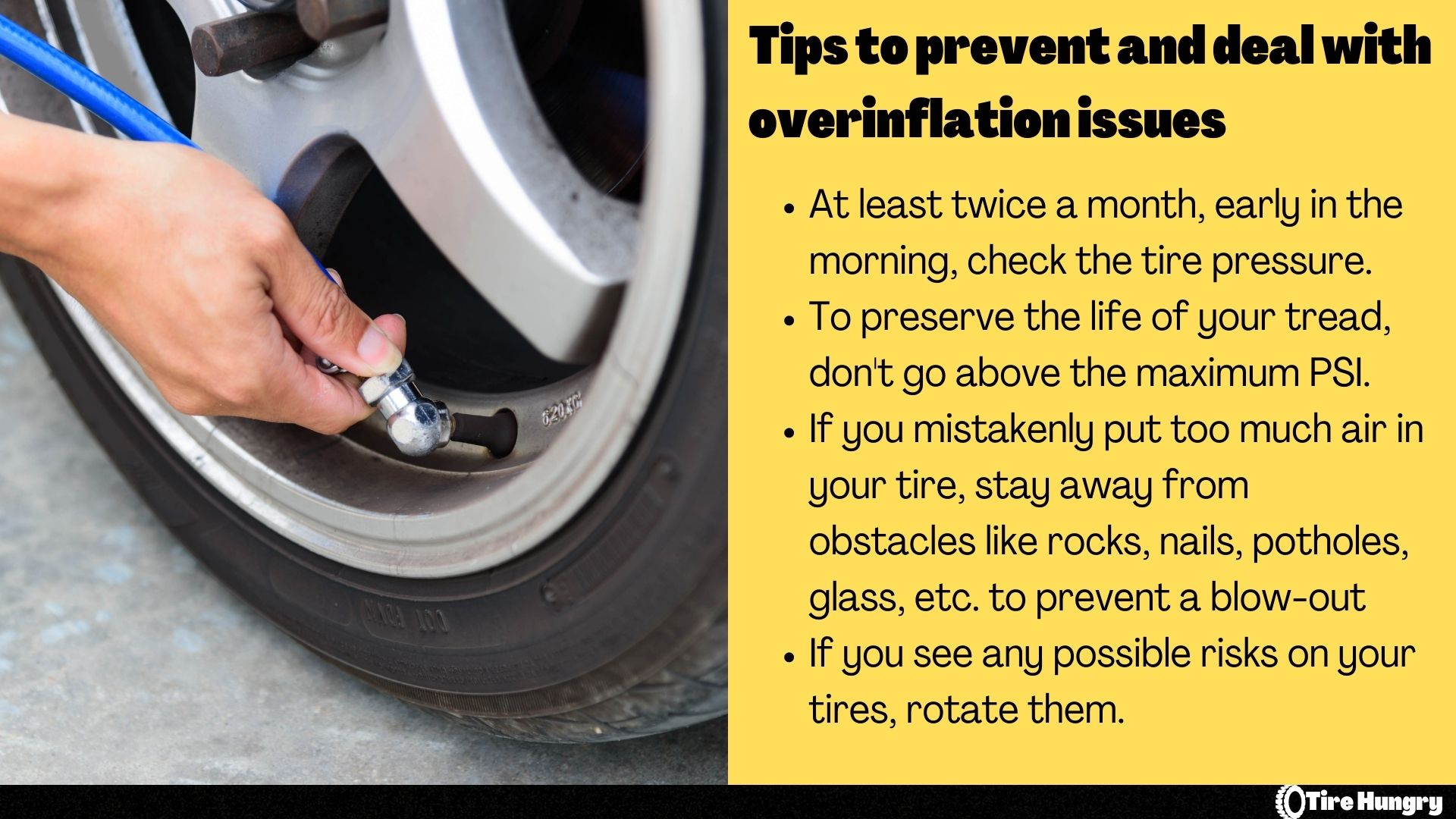
Ideally, whenever you want to check the pressure, you’ll need to do it at least a few hours after a drive, regardless of how short it was. The best course of action is to have a tire pressure gauge or inflation kit. With these, you can check and adjust the pressure without moving the car.
In a situation where things aren’t as convenient, and you don’t have all the tools available at your disposal, you’ll have to do things the old-fashioned way. I’m not recommending this if you’re not sure. Let’s say one of your tires is overinflated by a lot, almost to a point where you can see some slight deformation. Driving with this kind of tire can be dangerous, and you don’t have the tools. Here, you’ll have to improvise.
As part of the core of the valves on the rim are small nipples that act as “brakes,” preventing air from escaping the tire. If you press them, the valve opens up, and the tire deflates. You can eyeball this and deflate the tire enough until you feel it’s safe to be driven. As good as you think you are, a pressure gauge is better, so take your car to a tire shop to have the tires checked and adjusted.
Conclusion
Overinflating is one of the things you shouldn’t do. Going above the pressure recommendation set by the car manufacturer risks damaging the tire and exposes you to an unsafe driving experience.
The critical thing to know is that an overinflated tire is fixable as long as there isn’t any permanent damage, like uneven wear. Once you identify the overinflated tire, you can deflate it with a tool you have at home or take it to a tire shop. It’s important to know that checking and adjusting the pressure is something you should do only when the tires are cold. If you’ve driven the car recently, you won’t get correct readings.
As always, tires don’t keep the pressure the same as the day they got installed, so you need to check them constantly. Cars with TPMS sensors that show the exact pressure are convenient, as you can always get the readout. The rest of us need to check them at least once a month to ensure that we’re as close to the recommended pressure as possible.
